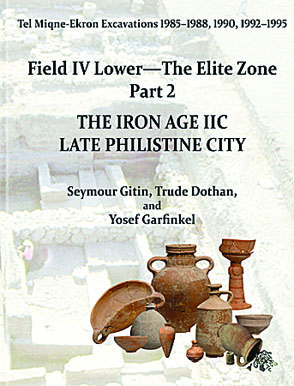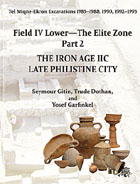
Tel Miqne 9/2
The Iron Age IIC: Late Philistine City
Seymour (Sy) Gitin, Trude Dothan, Yosef Garfinkel, with contributions by David Ben-Shlomo, Amir Golani, Baruch Brandl, Ianir Milevski, Edward F. Maher, Brian Hesse, Omri Lernau, Erik Steinbach, and Alexandra S. Drenka
Tel Miqne 9/2
The Iron Age IIC: Late Philistine City
Seymour (Sy) Gitin, Trude Dothan, Yosef Garfinkel, with contributions by David Ben-Shlomo, Amir Golani, Baruch Brandl, Ianir Milevski, Edward F. Maher, Brian Hesse, Omri Lernau, Erik Steinbach, and Alexandra S. Drenka
This well-illustrated volume presents the evidence from Stratum Pre-IC of the end of the 8th century, from Strata IC and IB of the 7th century, when Ekron achieved the zenith of its physical growth and prosperity, and from Stratum IA, the final Iron Age IIC phase of the early 6th century BCE. It offers a detailed discussion of the Iron Age IIC occupational history; a comprehensive analysis of the ceramic assemblages; a quantitative analysis of the pottery from the main Stratum IB buildings; and studies on vessel capacity, ceramic, lithic, ivory, and metal objects, jewelry, scarabs, faunal remains, and fish bones.
- Description
- Table of Contents
- Subjects
- Links
Published under the auspices of the Harvard Museum of the Ancient Near East, this volume concludes the publication of the results of the nine seasons of excavation conducted in Field IV Lower between 1985 and 1995, directed by Trude Dothan and Seymour Gitin and sponsored by the W. F. Albright Institute of Archaeological Research and the Hebrew University of Jerusalem.
Companion volumes published in 2016:
—Field IV Lower—The Elite Zone, Part 1: The Iron Age I Early Philistine City by Trude Dothan, Yosef Garfinkel and Seymour Gitin;
—Part 3A: The Iron Age I and IIC Early and Late Philistine Cities Database (see links tab);
—Part 3B: The Iron Age I and IIC Early and Late Philistine Cities Plans and Sections
The final reports on the two large Iron Age I and IIC Philistines cities in Field IV Lower offer a comprehensive view of the history of Ekron from its initial establishment and development in the Iron Age I until its destruction in the late Iron Age II. The searchable database and print version of the sections and plans provide a unique opportunity for readers to access and evaluate the excavators’ observations and conclusions.
Preface
Map of Philistine Coastal Plain and Shephelah Sites in the Iron Age
Top Plan of Tel Miqne-Ekron Showing Fields of Excavation
Tel Miqne-Ekron Iron Age II Stratigraphic and Chronological Chart
Tel Miqne-Ekron Field Reports and Monographs
Excavation Staff
Photos of Staff and Student Volunteers
Abbreviations and Additional Terms Used in Pottery Reading
Introduction
Chapter 1. Occupational History: The Stratigraphy and Architecture of Iron Age II Strata Pre-IC, IC, IB, and IA . 1
Chapter 2. The Iron Age II Pottery Quantification Project
Chapter 3. A Quantitative Analysis of the Pottery from Stratum IB in Temple Auxiliary Buildings 651–654: Character and Function
Chapter 4A. The Iron Age IIC Pottery
Chapter 4B. Capacities of Iron Age IIC Pottery Types
1. Use of Computer-Aided Graphic Design (CAGD) to Estimate the Capacity of Ceramic Vessels
2. Vessel Capacity Analysis
Chapter 4C. Pottery Quantification Data: Pottery Types in Architectural Units and Sub-units by Stratum
Chapter 5. Iron Age II Ceramic Small Finds, Faience Seals, Ivory Objects, and Astragali
Chapter 6. The Jewelry from Iron Age II Contexts
Chapter 7. The Iron Age II Metal Artifacts
Chapter 8. An Iron Age II Cowroid and Three Scarabs
Chapter 9. Iron Age II and Roman Period Stone Tools and Vessels
Chapter 10. The Iron Age II Faunal Remains
Chapter 11. The Fish Bones from Iron Age I Strata VII–IV and Iron Age II Strata Pre-IC, IC, IB, and IA
Color Figures and Photos
Bibliographic Abbreviations and References
Ekron 9/3A, the complete excavation database, is available at http://semiticmuseum.fas.harvard.edu/publications:
Appendix 1: Area Context Charts with locus, stratum, phase, building, and room designations;
Appendix 2: Area Phasing Charts with locus, stratum, phase, field pottery readings, and stratigraphic relationships; Index A: Locus Summaries; and Index B: Material Culture Samples
Part 3A: The Iron Age I and IIC Early and Late Philistine Cities Database available available at http://semiticmuseum.fas.harvard.edu/publications.
Also of Interest
Mailing List
Subscribe to our mailing list and be notified about new titles, journals and catalogs.




.jpg)